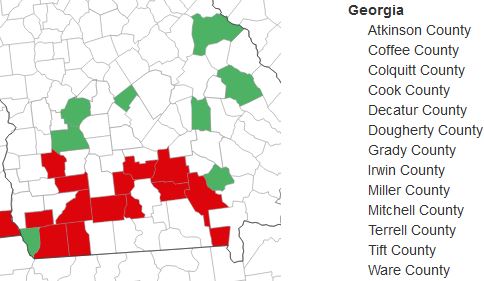Crop Disease and Insect Update
Disease Update (Dr. Bob Kemerait)
Southern Corn Rust found yesterday in Terrell County. This is a new detection moving slightly north; corn farmers in South Georgia have been dealing with this disease since early June, corn growers in north Georgia should be vigilant. Conditions now are absolutely perfect for southern corn rust, soybean rust (I would make R3 fungicide application), cotton target spot (consider fungicide or not at 3rd week of bloom), and peanut leaf spot/white mold diseases. The 800 pound gorilla in the room has a name. It is “Elsa”. I would be happy if Elsa continues to slide east and misses us, but we can’t bank on hopes. Growers in Georgia should prepare for a storm that could: a) prolong favorable disease conditions, b) delay re-entry into field and delay fungicide applications, and c) move spores and disease.
Recommendations:
1) It is better to be protected ahead of the storm than behind.
2) For some peanut farmers an aerial application may be the only option. I’m not convinced we always get the same “bang for our buck” when considering air versus ground, but TIMELINESS is MOST essential now. UGA recommendations for fungicides are based on disease and growth stage/time of season, not whether by air or ground.
3) Be timely now; be ready to follow up with another strong application of fungicide on peanuts when you can get back in the fields.
What growers do now for all crops will likely have season-long impact.
Following is a current image of southern corn rust for Georgia. It is likely that SCR could be present in Worth County, also, based on confirmations from surrounding counties. Many growers applied protective fungicide sprays earlier in June. If there is suspect rust found, we can help check it out and confirm if it is or is not southern corn rust. Let us know at Worth County Extension.

Insect Update
Cotton – There are reports of some fields with tarnished plant bugs. Plant bug numbers can vary from field to field, so scouting for their presence or damage is the best way to know. Sweep nets are a good tool for sampling adult plant bugs in cotton. Thresholds for plant bugs with a sweep net are: 8 plant bugs per 100 sweeps, during the first two weeks of squaring; 15 bugs per 100 sweeps, beginning the third week of squaring. Also, monitor the field for square retention. Fields should be treated if first position square retention drops below 80% and plant bugs are present. Once cotton begins to bloom, a drop cloth is a good tool to monitor for immature plant bugs. Aphid populations can be light or heavy in differing fields. Treatment can be necessary, but as populations get heavy, the aphid fungus will wipe out aphids; to date, we are not aware of the aphid fungus being present. As cotton begins setting bolls, scouts should pull developing bolls about the diameter of a quarter to check for damage. The decision aid for stink bug thresholds in cotton is pictured below and shows the dynamic threshold for % internal boll damage based on week of bloom. For more information contact your local county agent.

If we can be of assistance to you at Worth County Extension, please let us know.